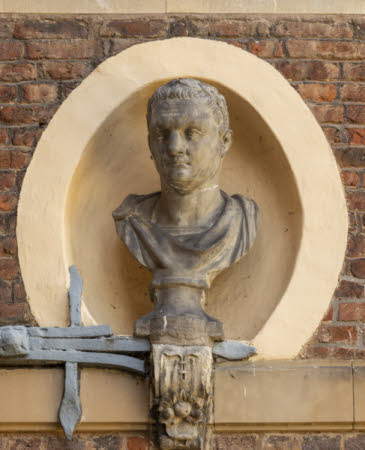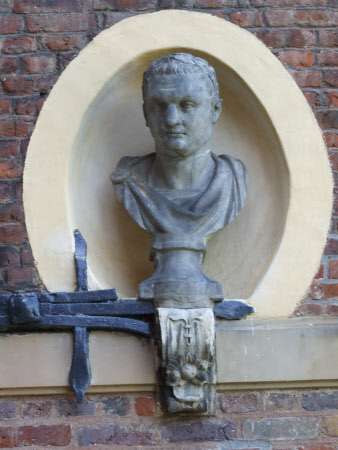Bust of a Roman emperor
workshop of John Besnier (fl.1681)
Category
Art / Sculpture
Date
c. 1670 - 1672
Materials
Lead, Sandstone
Place of origin
London
Order this imageCollection
Ham House, Surrey
NT 1140354
Summary
A lead portrait bust of a Roman emperor, wearing armour and a cloak. One of thirty-eight lead busts made for the garden walls of Ham House in 1671-72, perhaps in the workshop of John Besnier, thirty-six of which survive in niches on the walls and on the north façade of the house. .
Full description
A lead portrait bust of a Roman emperor, with a heavy Roman nose and shortish hair, looking to his right. He wears armour and, over this, a cloak fastened with a brooch at his right shoulder. In his hair is a laurel wreath. Mounted on a plinth, and placed on a scrolling sandstone console with a panel with stitching and, below, a bunch of fruit and leaves. One of thirty-six lead busts displayed in oval niches in the garden walls and on the north façade of Ham House, probably installed in 1671-72, and recorded in the 1679 inventory of Ham House. The entire series was probably arranged in its present positions along the garden walls and on the north front of Ham House by the 6th Earl of Dysart, as part of improvements undertaken between 1798 and 1803. Although along the garden walls all the busts are of male subjects, on the north front of the house, the the busts are a mixture of portraits of male and female subjects. This bust is one of only two in the house sequence that depict, both based on the same model (the other is NT 1140349). As there are only eleven busts along each garden wall, these therefore represent the twelfth emperor, making up the sequence of the Twelve Caesars, of which there are two at Ham. The long series of lead busts may well, like other sculpture at Ham House, have been made in the workshops of the Besnier family, perhaps by John Besnier, who received a commission for lead statuary from the Duke of Ormonde in 1681. They were originally painted so that they would appear, at least from a distance, to be made of marble. For a fuller discussion of the lead busts and their history and attribution, see NT 1140333. Jeremy Warren January 2022
Provenance
Probably made installed in 1671-72 to the commission of John Maitland and Elizabeth Murray, 1st Duke and Duchess of Lauderdale. Thence by descent, until acquired in 1948 by HM Government when Sir Lyonel, 4th Bt (1854 – 1952) and Sir Cecil Tollemache, 5th Bt (1886 – 1969) presented Ham House to the National Trust. Entrusted to the care of the Victoria & Albert Museum until 1990, when returned to the care of the National Trust, to which ownership was transferred in 2002.
Makers and roles
workshop of John Besnier (fl.1681), sculptor
References
Avery 2013: Charles Avery, ‘Seventeenth-century Sculpture at Ham House’ in Christopher Rowell, ed., Ham House. 400 Years of History, New Haven/London 2013, pp. 158-77., pp. 172-76.

